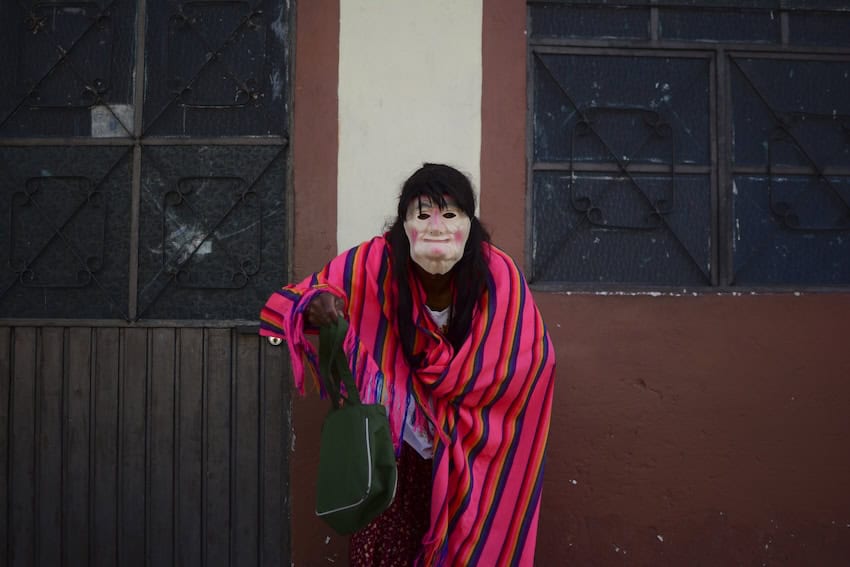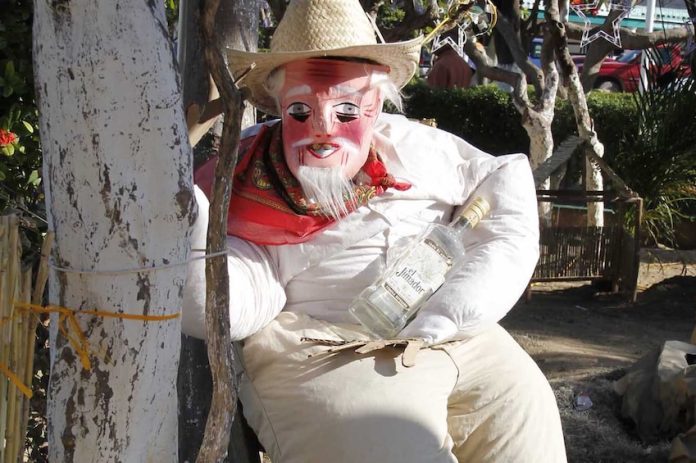There’s nothing more distinctly representative of the holidays in Veracruz than spotting your first “old man” wandering the streets — sometimes on fire. To the uninitiated it may sound odd, if not violently eerie. But it’s a reference to a century-old celebration known as “El Viejo de Año Nuevo,” in which “Jarochos” (Veracruz natives) throughout the coastal state end every year within a festive spectacle. And it’s worth seeing the uniquely Veracruzano custom.
The state’s upbeat reputation is on full display as hordes of participants spread joy in the form of dance and music while dressed up old men and occasionally old women (characterized by fake white hairs, a disheveled beard for the men, a cane, and often a Jarocho outfit of white guayabera shirt and pants, with a matching white hat or traditional dress for the ladies). In many indigenous communities, the “old man” is represented with traditional masks and songs. Whatever the appearance, “El Viejo de Año Nuevo” is one of the state’s proudest traditions, bringing together participants of various ages for the annual, intergenerational affair.

It begins on Christmas Day, which in Mexico is predominantly celebrated as Nochebuena on Christmas Eve and ends on January 1. There are variations of the celebration, too. In some places, there is “la quema del viejo.” In this case, effigies of old men get burned at midnight to reset the calendar and ward off negative spirits. These effigies are dressed up to appear as elders, and are customarily stuffed with dried banana leaves. The burning of these “old men” dates back centuries to traditions brought over from the Spaniards. And not every community partakes in the pyres, either.
For my parents and family members who grew up in Veracruz’s capital, Xalapa, each año nuevo began afresh with “El Viejo,” something as customary for them as it is to eat tamales and pambazos. My dad recounts his memories as a child and adolescent in Xalapa. In his retelling, he and his friends would go around Xalapa and watch people of all ages dressed as old men as they played music, asked for money, and sang the age-old lyrics (which has since been modernized into various remixes) past midnight.
The celebratory procession is said to have started as a labor protest in 1875 in the port city of Veracruz. As the legend goes, a group of dock workers didn’t receive their annual “aguinaldo,” or Christmas bonus, and began to demand their dues by gathering in the streets. Another version of the story differs in that the workers were demanding to take home unclaimed shipments at the end of the year, as was customary, but were forcefully denied by the port’s managers.
In response to not receiving the end-of-year rewards, a man who is simply known by his last name, Bovril, took charge and began to make noise outside of the port managers’ homes, until crowds of more workers gathered, with the intent to collect money and goods. The next year, the dock workers repeated their actions but dressed up as old men, or “viejos.” It’s unclear exactly how the costume became popularized.
In a vastly different telling, multiple sources have also cited a Korean immigrant who brought over the custom while wearing a mask in the streets of Veracruz until children started to follow him around, dancing and singing. Whatever the origin, it’s stronger than ever in Veracruz, where the current Governor, Rocío Nahle García, is currently pushing a campaign to celebrate the custom with tourists and locals alike with the tagline “¡Veracruz está de la moda!”. But for many, it doesn’t need any marketing, since it’s a practice that has been passed down over generations.
“It’s a culture that is preserved in every pueblo,” said a participant in an interview with Cronica de Xalapa. “We maintain the musical aspect. That’s what keeps the tradition fresh. We add rhythm and it keeps us united by bringing more joy to homes.”
To be sure, every region throughout Veracruz — including Cordoba, Veracruz-Boca del Río, Xalapa, Orizaba and many others — will host their own version of a parade. The state’s main event will take place at Parque Zamora in Veracruz beginning at 1 p.m. In the evening, a fireworks display will occur at nearby la Plaza del Migrante Libanés, Villa del Mar, Asta Bandera, Hotel Lois y Plaza de los Valores.
Alan Chazaro is the author of This Is Not a Frank Ocean Cover Album , Piñata Theory and Notes From the Eastern Span of the Bay Bridge (Ghost City Press, 2021). He is a graduate of June Jordan’s Poetry for the People program at UC Berkeley and a former Lawrence Ferlinghetti Fellow at the University of San Francisco. His writing can be found in GQ, NPR, The Guardian, L.A. Times and more. Originally from the San Francisco Bay Area, he is currently based in Veracruz.
